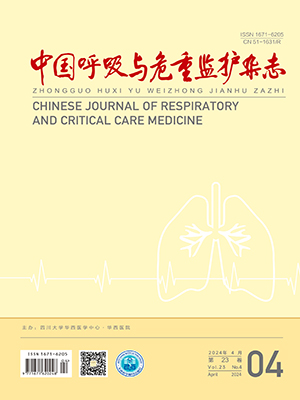| 1. |
Feng HM, Zhao Y, Yan WJ, et al. Genomic and immunogenomic analysis of three prognostic signature genes in LUAD. BMC bioinformatics, 2023, 24(1): 19.
|
| 2. |
Li X, Dai Z, Wu X, et al. The Comprehensive Analysis Identified an Autophagy Signature for the Prognosis and the Immunotherapy Efficiency Prediction in Lung Adenocarcinoma. Front Immunol, 2022, 13: 749241.
|
| 3. |
Liu Y, Yu M, Cheng X, et al. A novel LUAD prognosis prediction model based on immune checkpoint-related lncRNAs. Front Genet, 2022, 13: 1016449.
|
| 4. |
李静, 刘晓琴, 杨业, et al. LncRNA KCNQ1OT1在非小细胞肺癌组织中的表达及其临床意义. 中国呼吸与危重监护杂志, 2016, 15(5): 453-457.
|
| 5. |
Lou Y, Shi Q, Zhang Y, et al. Multi-Omics Signatures Identification for LUAD Prognosis Prediction Model Based on the Integrative Analysis of Immune and Hypoxia Signals. Front Cell Dev Biol, 2022, 10: 840466.
|
| 6. |
Barton M, Santucci-Pereira J, Vaccaro OG, et al. BC200 overexpression contributes to luminal and triple negative breast cancer pathogenesis. BMC Cancer, 2019, 19(1): 994.
|
| 7. |
Sun J, Guo Y, Bie B, et al. Silencing of long noncoding RNA HOXD-AS1 inhibits proliferation, cell cycle progression, migration and invasion of hepatocellular carcinoma cells through MEK/ERK pathway. J Cell Biochem, 2020, 121(1): 443-457.
|
| 8. |
Chen Z, Hu Z, Sui Q, et al. LncRNA FAM83A-AS1 facilitates tumor proliferation and the migration via the HIF-1α/ glycolysis axis in lung adenocarcinoma. Int J Biol Sci, 2022, 18(2): 522-535.
|
| 9. |
Lin Z, Feng F, Liang J, et al. lncRNA RP11-10A14.5: a potential prognosis biomarker for LUAD through regulation on proliferation and metastasis. Discov Oncol, 2022, 13(1): 32.
|
| 10. |
Liu Y, Liang L, Ji L, et al. Potentiated lung adenocarcinoma (LUAD) cell growth, migration and invasion by lncRNA DARS-AS1 via miR-188-5p/ KLF12 axis. Aging (Albany NY), 2021, 13(19): 23376-23392.
|
| 11. |
Xing C, Sun SG, Yue ZQ, et al. Role of lncRNA LUCAT1 in cancer. Biomed Pharmacother, 2021, 134: 111158.
|
| 12. |
Hin Tang JJ, Hao Thng DK, Lim JJ, et al. JAK/STAT signaling in hepatocellular carcinoma. Hepat Oncol, 2020, 7(1): Hep18.
|
| 13. |
Liu C, Feng H, Song L, et al. Synergistic effects of thalidomide and cisplatin are mediated via the PI3K/AKT and JAK1/STAT3 signaling pathways in cervical cancer. Oncol Rep, 2022, 48(4): 169.
|
| 14. |
Taniuchi K, Ogasawara M. KHSRP-bound small nucleolar RNAs associate with promotion of cell invasiveness and metastasis of pancreatic cancer. Oncotarget, 2020, 11(2): 131-147.
|
| 15. |
Pan R, Cai W, Sun J, et al. Inhibition of KHSRP sensitizes colorectal cancer to 5-fluoruracil through miR-501-5p-mediated ERRFI1 mRNA degradation. J Cell Physiol, 2020, 235(2): 1576-1587.
|
| 16. |
Xu F, Huang X, Li Y, et al. m(6)A-related lncRNAs are potential biomarkers for predicting prognoses and immune responses in patients with LUAD. Mol Ther Nucleic Acids, 2021, 24: 780-791.
|
| 17. |
Wu S, Huang X, Tie X, et al. Role and mechanism of action of circular RNA and laryngeal cancer. Pathol Res Pract, 2021, 223: 153460.
|
| 18. |
罗汶鑫, 李为民. 肺癌的表观遗传学研究进展及其临床意义. 中国呼吸与危重监护杂志, 2018, 17(3): 313-318.
|
| 19. |
Zhang G, Sun J, Zhang X. A novel Cuproptosis-related LncRNA signature to predict prognosis in hepatocellular carcinoma. Sci Rep, 2022, 12(1): 11325.
|
| 20. |
Song J, Sun Y, Cao H, et al. A novel pyroptosis-related lncRNA signature for prognostic prediction in patients with lung adenocarcinoma. Bioengineered, 2021, 12(1): 5932-5949.
|
| 21. |
Song H, Liu Y, Jin X, et al. Long non-coding RNA LINC01535 promotes cervical cancer progression via targeting the miR-214/EZH2 feedback loop. J Cell Mol Med, 2019, 23(9): 6098-6111.
|
| 22. |
He L, Tian L. Downregulation of miR–409–3p suppresses LPS–induced inflammation in human bronchial epithelial cells through SOCS3/JAK1/STAT3 signaling: The implication for bronchopneumonia. Mol Med Rep, 2021, 23(3): 190.
|
| 23. |
Zhao X, Cheng Z, Wang J. Long Noncoding RNA FEZF1-AS1 Promotes Proliferation and Inhibits Apoptosis in Ovarian Cancer by Activation of JAK-STAT3 Pathway. Med Sci Monit, 2018, 24: 8088-8095.
|
| 24. |
Jiang Y, Xu CH, Zhao Y, et al. LINC00926 is involved in hypoxia-induced vascular endothelial cell dysfunction via miR-3194-5p regulating JAK1/STAT3 signaling pathway. Eur J Histochem, 2023, 67(1): 3526.
|
| 25. |
Chen YD, Cai FY, Mao YZ, et al. The anti-neoplastic activities of aloperine in HeLa cervical cancer cells are associated with inhibition of the IL-6-JAK1-STAT3 feedback loop. Chin J Nat Med, 2021, 19(11): 815-824.
|
| 26. |
Du Y, Zhang JY, Gong LP, et al. Hypoxia-induced ebv-circLMP2A promotes angiogenesis in EBV-associated gastric carcinoma through the KHSRP/VHL/HIF1α/VEGFA pathway. Cancer Lett, 2022, 526: 259-272.
|
| 27. |
Ide S, Toiyama Y, Shimura T, et al. Angiopoietin-Like Protein 2 Acts as a Novel Biomarker for Diagnosis and Prognosis in Patients with Esophageal Cancer. Ann Surg Oncol, 2015, 22(8): 2585-2592.
|
| 28. |
Briata P, Bordo D, Puppo M, et al. Diverse roles of the nucleic acid-binding protein KHSRP in cell differentiation and disease. Wiley Interdiscip Rev RNA, 2016, 7(2): 227-240.
|
| 29. |
Yuan H, Deng R, Zhao X, et al. SUMO1 modification of KHSRP regulates tumorigenesis by preventing the TL-G-Rich miRNA biogenesis. Mol Cancer, 2017, 16(1): 157.
|
| 30. |
Yan M, Sun L, Li J, et al. RNA-binding protein KHSRP promotes tumor growth and metastasis in non-small cell lung cancer. J Exp Clin Cancer Res, 2019, 38(1): 478.
|




